This year, 2025, is my 10th year of trading cryptocurrency full-time. Last year, I spent a full 11 months doing contracts, going from 2000u to over 20 million now, a full 1000x profit.
First of all, as an ordinary person, it should not be difficult to take out 20,000 yuan.
Excluding the earliest players who got on the train in terms of time, calculate according to the time that ordinary people can understand. Bitcoin has experienced 4 cycles from 2016 to today.
Each cycle has a basic increase of 3-6 times. Because you can't buy at the absolute bottom or sell at the absolute top, let's just calculate it as 4 times after cutting off the head and tail. 4 cycles of 20,000 yuan can become: 5.12 million.
If the initial capital is 50,000, how much will 4 cycles become? 12.8 million.
Looking at these numbers, can ordinary people turn over?
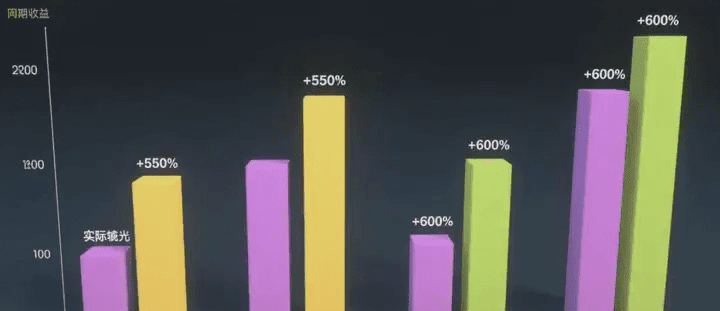
If you want to truly achieve financial freedom and compound interest in the crypto circle, methods, techniques, and the formation of your own profit system are crucial!
Once you learn to master it, the crypto circle will be like your "ATM", making money is as simple as breathing!
After more than 10 years of trading cryptocurrency, my wealth path is summarized as follows:
The first ten million took the longest and was the most painful. The trading system was constantly reshaped and polished, taking a year and a half.
The second ten million took three months.
The third ten million only took 40 days.
The fourth ten million only took 5 days.
75% of the funds were earned in half a year.
How I make money:
300U principal optimal contract trading method (efficient doubling plan) [worth repeated study]
Core principles: Strict position separation | Only do BTC+/ETH+ | Stop-loss > Take-profit | Limited to 3 times
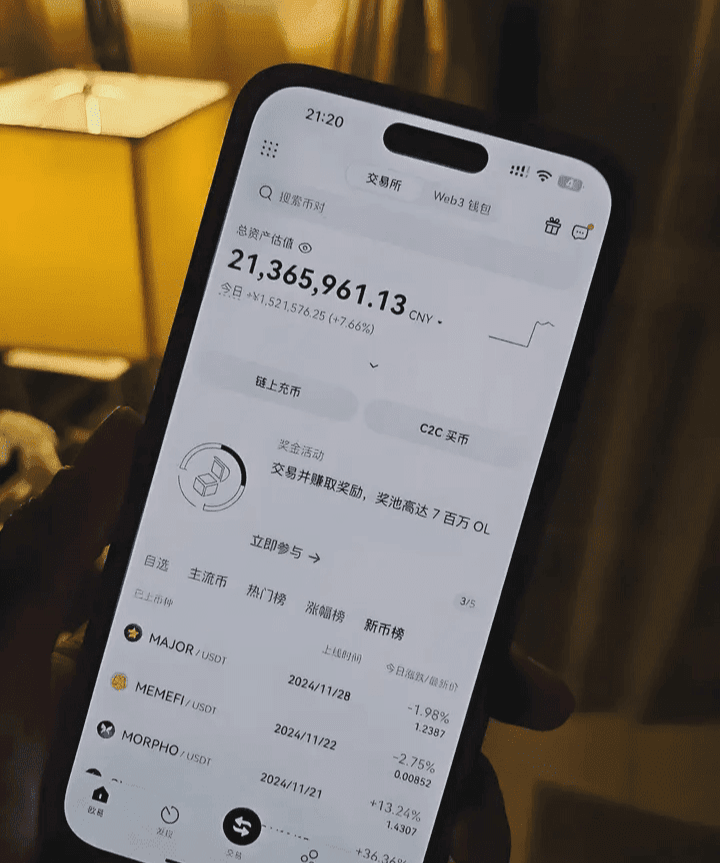
I. Starting stage: 300U → 1100U (3 levels sprint)
Strategy: 100U × 3 times, 10x leverage each time, 7% take profit/5% stop loss (profit-loss ratio 1.4:1)
Execution steps: Level 1 (100U → 200U) Goal: Profit of 70U (7% take profit) Stop loss: -50U (5%) Success → Enter Level 2, Failure → Remaining 200U adjust strategy
Level 2 (200U → 400U) Goal: Profit of 140U Stop loss: -100U Success → Level 3, Failure → Remaining 100U safety net
Level 3 (400U → 800U) Goal: Profit of 280U Stop loss: -200U Success → Principal reaches 1100U, enter stable strategy
A key discipline: Maximum 3 times! Whether successful or not, subsequently switch to a conservative approach and only trade BTC/ETH, reject altcoins (poor liquidity, high risk of pin insertion).
II. 1100U stage: Three-dimensional matrix strategy (ultra-short + swing + trend)
Fund allocation: Ultra-short order (300U) → 15-minute fast in and fast out Swing order (500U) → 4-hour level trading + profitable fixed investment in BTC
Trend order (200U) → Weekly big opportunity sniping reserve fund (100U) → Emergency additional position/sudden opportunity
1 Ultra-short orders (300U, intraday trading)
Strategy: 10x leverage, EMA12+MACD+(5,13,1) entry signal: 15-minute candlestick breaks the previous 3 high points + increased volume stop
Profit: 3%~5% (flexible moving stop loss) Stop loss: 2% forced stop loss Meltdown: 2 consecutive losses → pause for 1 hour
2. Swing order (500U, 4-hour level)
Strategy: 5x leverage, Bollinger band narrowing breakout Entry: 4H Bollinger band width <20% annual line, break through the upper rail to go long/lower rail to go short Stop loss: 1.5x bandwidth Profit handling: Weekly profit of 40% fixed investment in BTC
3. Trend orders (200U, weekly opportunities) Strategy: 3x leverage, waiting for extreme market conditions: Weekly RSI+(14)<30 (oversold) or >70 (overbought) Daily line 3 consecutive same-direction K-lines 4-hour TD sequence +=9 (reversal signal) Take profit: Moving stop loss, profit-loss ratio ≥3:1
III. Ultimate risk control (lifeline)
Daily loss >15% → Forced rest for 24 hours Weekly profit >30% → Halve the leverage the next day Monthly withdrawal of 20% of profit → Secure the profits
Summary: First 3 levels (100U × 3 times) → Quickly accumulate principal later stage (1100U) → Ultra-short + swing + trend combination Discipline > Technology! Reject carrying orders, reject frequent trading
This way of playing can not only gamble for high returns, but also control risks, which is suitable for players starting with 300U!
Special attention:
1. Only do high selling and low buying of BTC/ETH.
2. Mainly use the moving average group of important pressure above the 4H level to judge the batch entry of short orders. For example, the MA60 moving average above the 4H level has been continuously suppressing the price, then use this moving average as the timing of short order entry Stop loss: Just put it on the previous high after the pin is inserted upwards and then falls back, for example, the pressure level is at 2440, the pin is inserted to 2450, then the stop loss is placed above 2450.
3. Generally use the lower support of the same level or one level larger as the point for batch entry of long orders Stop loss: Just put it on the previous low after the pin is inserted downwards and then rises, for example, the support level is at 2320, the pin is inserted to 2310, then the stop loss is placed below 2310, near 2300
4. Stop-loss principal: 20% of the total principal. No more orders will be placed on the same day if this is reached. Generally, each day's operations are based on two transactions, with the single stop-loss controlled at 10%. The position size of each order should be consistent.
5. Try to enter the market in batches as the main method, and do not fill all the bullets at once! . Try to follow the trend to open orders, when the main theme is short, try to open short orders, and vice versa.
① When the market trend is good, chase hot coins
② Control the profit-loss ratio to be around 3:1
③ Daily stop-loss drawdown is 15%-20% of the principal, and no more orders will be placed on the same day if this is reached.
④ Daily review
6. Smashing market: Wait empty and wait for batch to pick up the needle to enter the market, if there is no opportunity, just wait empty, in this market, not losing money is equal to making money
7. Profit-guaranteed stop loss: When the order placed on the same day does not appear to have a stop loss and the same-level K-line form does not show form damage, you do not need to bring a profit-guaranteed stop loss pattern! You must bring a profit-guaranteed stop loss if either of the two conditions is not met. ETH: Profit-guaranteed after 20 points of floating profit BTC: Profit-guaranteed after 350 points of floating profit
8. Moving take profit: ETH: Do moving take profit after 35 points of floating profit, use 3/5 minute level to do moving BTC: Do moving take profit after 500 points of floating profit, use 3/5 minute level to do moving
9. 1. Never think about going all-in for a sudden fortune, 2. Only do the market that belongs to you! Learn to stay empty, don't force orders 3. Don't do overnight orders, 4. Try not to open orders on weekends 5. After being stopped out, control your mentality.
I have sorted out the essence of [RSI Swing Trading], "14 charts teach you the ultimate secret of RSI swing trading" As long as you master it, relying on this method of trading cryptocurrency, the account is guaranteed to double 30 times. Today I specially sorted out the dry goods and shared them with destined people, please collect them carefully.
Without a doubt, the Relative Strength Index (RSI) is perhaps one of the most commonly used technical indicators by traders worldwide. It is a momentum oscillator developed by J. Welles Wilder, a well-known Wall Street trader, to capture the speed and change of price movements.
To this end, it is expressed as a value from 0 to 100, where values below 30 are considered 'oversold' and values above 70 are considered 'overbought'. In this way, the indicator can draw attention to potential turning points in the current trend, which may lead to corrections in the existing long-term trend or even trigger real trend changes.
RSI Calculation Formula
The RSI is typically calculated using the following formula:
RSI = 100 - [100 / (1 + RS)]
Where RS (Relative Strength) is the average of x-day closing prices up divided by the average of x-day closing prices down. The most common period is 14 days, but traders can adjust this value according to their preferences and trading style.
RSI levels
Between 0 and 30: Extremely oversold
Values below 30 indicate that the market is in a severely oversold state. Traders will pay attention to possible changes in the price trend, that is, the existing downward trend may turn into a new upward trend.
However, this is not absolute. Always remember that a falling trend with strong momentum can cause the indicator to remain in the extremely oversold region for a long time. Therefore, it is not a good strategy to blindly buy just because the value is below 30.
Between 30 and 50: Slightly oversold to neutral
Values above but close to 30 indicate that the market is slightly oversold. If the value is closer to 50, it is more likely to be a neutral state.
Between 50 and 70: Neutral to slightly overbought
Values above but close to 50 are also neutral. However, if the value is close to the 70 level, it indicates that the market is slightly overbought.
Between 70 and 100: Extremely overbought
This area is considered an extremely overbought area, and the market believes that the upward trend may lose momentum, and a true trend reversal may occur, turning into a downward trend.
Nevertheless, the same observations as for oversold situations also apply here. A strong rise may attract more buyers to enter the market, causing the RSI to skyrocket. This does not mean that the market cannot continue to rise strongly indefinitely.
Again, one should not automatically close long positions (or open short positions) simply because the indicator is in an extremely overbought state.
"Please keep in mind that these ranges are only indicative and should never be used as pure trading signals. Without additional elements to confirm overbought or oversold situations, the probability of false signals is very high."
Which settings to use?
The best parameter selection for the indicator depends entirely on personal preference, mainly depending on the strategy you use and the timeframe in which it is executed.
The default setting is 14 periods, with an upper limit of 80 and a lower limit of 30. Typical swing traders sometimes use 20 periods, as this roughly corresponds to a 1-month trading cycle on the daily chart.
Another option is to set the upper and lower limits to 80 and 20, respectively, slightly tightening the range. This will result in fewer signals, but the signals will become more reliable and reduce the occurrence of false signals.
Overbought and Oversold Levels
The horizontal axis represents time, and the vertical axis has a value range of 0 to 100 (which is why the indicator is called an oscillator).
◎ Above 50: The technical trend is positive.
◎ Below 50: The technical trend is negative.
It measures the speed and direction of price movements.
The general rule is:
◎ When the value is above 70, it is called an 'overbought' signal, which means that the price has risen sharply in a relatively short period, and the possibility of a (temporary) decline increases.
◎ When the value is below 30, it is called an 'oversold' signal, which means that the price has fallen sharply, and the possibility of a (temporary) rebound increases.
Visually, the indicator looks like this, you can identify peaks above 70 and troughs below 30:
The RSI as exemplified by the stock chart of energy company Cenovus Energy:
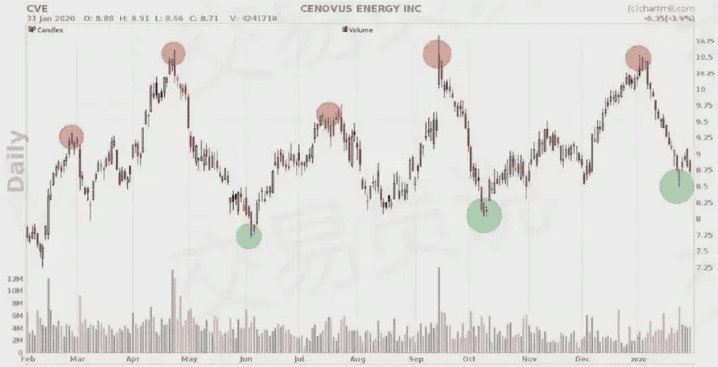
The red circles in the figure indicate sell signals, and the green circles indicate potential buy signals. Any trader who buys at the green circles and sells at the red circles has earned very considerable profits!
This chart shows that RSI levels provide good signals primarily in sideways markets.
3 Different Ways to Use These Levels in Trading Strategies
We emphasize that the reliability of the RSI indicator is highly dependent on the market stage of the stock or market.
We distinguish the following stages:
◎ The price is in a sideways channel (consolidation area).
◎ The price shows a clear upward trend.
◎ The price shows a clear downward trend.
1. Sideways price channel
In a sideways price channel, we have seen classic buy and sell signals (buy at <30, sell at >70) are relatively reliable.
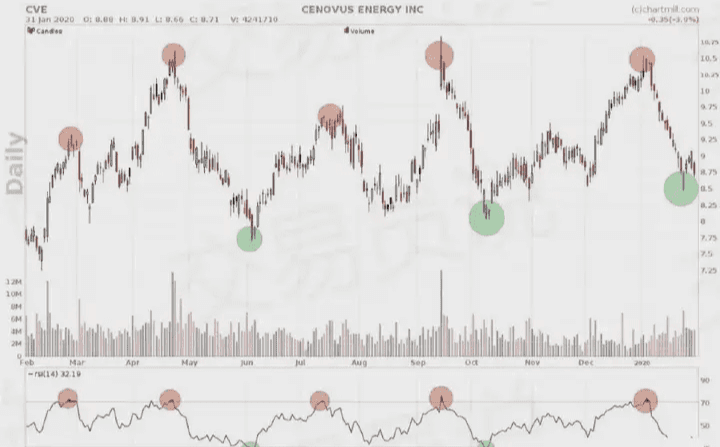
The stock price fluctuates roughly in a wide sideways channel between $10.75 and $7.50. Each time it reaches one of the two limits, the price falls or rises. In this case, the RSI shows accurate signals.
2. Uptrend
In prices with a clear upward trend, the classic use is much less effective. The strong upward trend in the chart below is obvious at a glance.
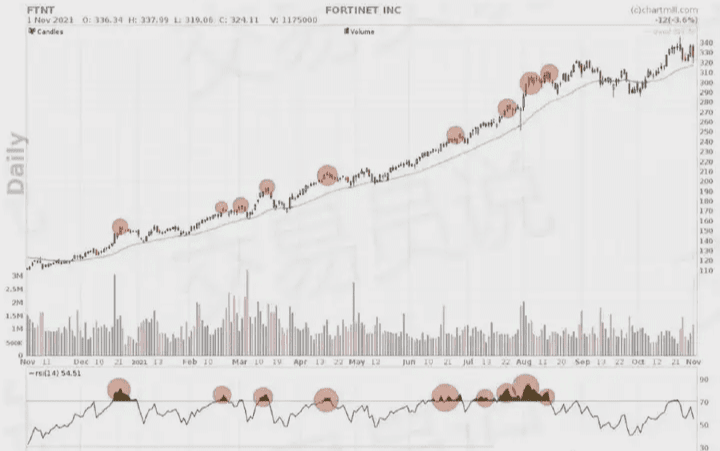
As long as the trend continues to rise, it is recommended to ignore sell signals. In this case, you can try to buy on temporary dips in the uptrend.
Of course, you can also use the RSI indicator to achieve this goal. In the figure below, we show the same chart but ignore the sell signals and mark the moments when the RSI value falls below the 50 level.
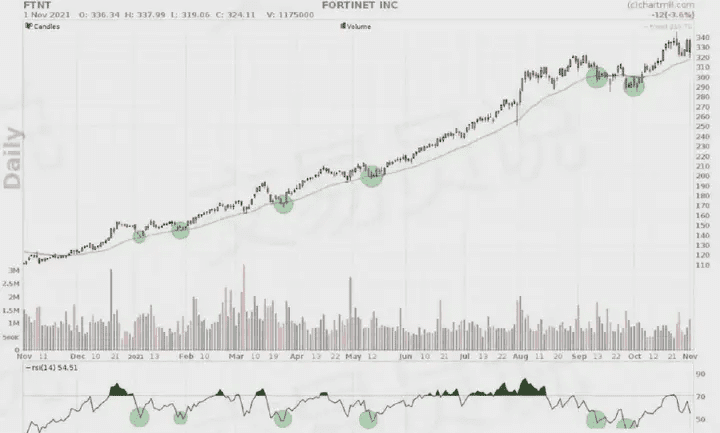
In an uptrend, buying when the RSI falls below 50 usually yields very good results and allows you to increase positions in the same stock (or other instruments).
3. Downtrend
Similar to an upward trend, in a sharply declining trend, the RSI can also be used to short if the price temporarily rebounds. In the figure below, we have marked the points where the trend indicator shows a downward trend (red line), and the occasional price rebounds, at which point the trend indicator becomes neutral (gray) but never turns positive (green).
At these moments, when the RSI value exceeds 50, the indicator shows a sell signal.
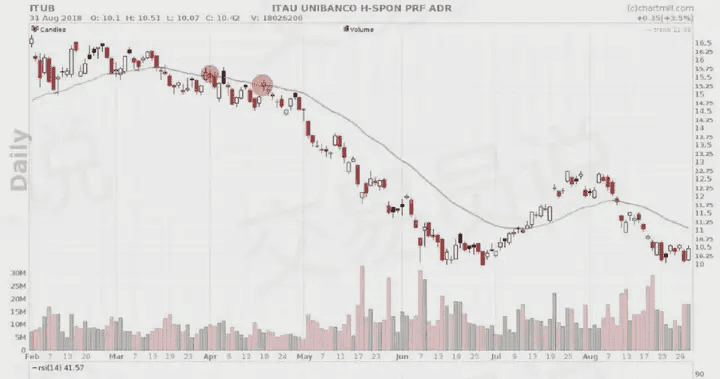
"In stocks that show strong price trends (up or down), the classic lower and upper limits (30 and 70) are too extreme in many cases. In this case, the 50 level is more suitable for identifying overbought or oversold periods."
The power of divergence: early discovery of new price trends
Divergence means there is a difference between the price evolution on the chart and the indicator's movement.
Since this divergence typically occurs near the end of an existing long-term trend, active investors use them to identify early changes in long-term price trends, thereby opening new positions in the direction of the reversed trend.
Divergence is divided into bullish (positive) divergence and bearish (negative) divergence.
Bullish RSI Divergence
Bullish Divergence occurs when the price chart still shows a lower bottom, while the RSI chart line shows the opposite trend. This is a signal that the strength and momentum of the falling price trend are weakening (at least temporarily), increasing the possibility of a temporary rebound in prices.
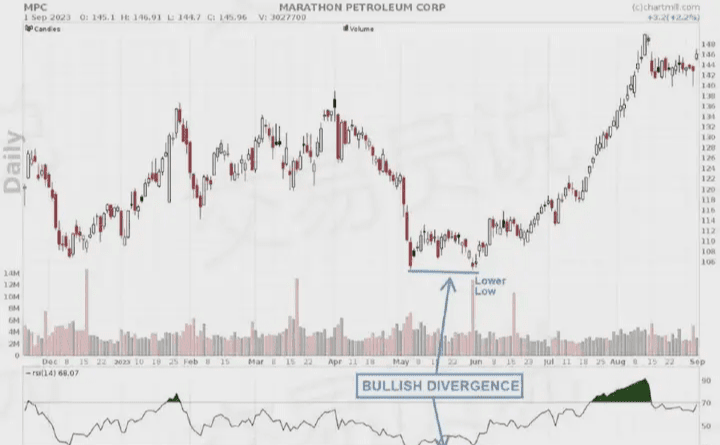
Bearish RSI Divergence
A bearish divergence occurs when the indicator shows a lower top while the price is still rising. This indicates that the strength and momentum of the rise are weakening (at least temporarily), and there is a possibility of a (mid-term) price decline.
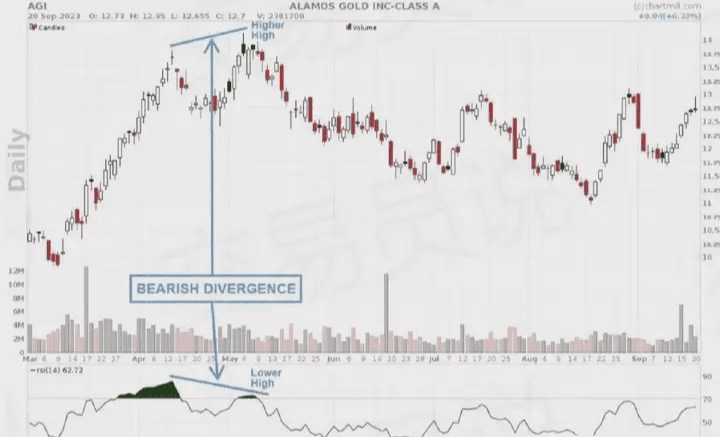
Hidden Divergence: Capitalizing on Temporary Price Changes in Existing Trends
This form of divergence is a derivative of classical divergence and mainly appears in stocks with obvious upward or downward trends.
Hidden divergence appears when prices temporarily fall in an uptrend or temporarily rebound in a downtrend.
Example 1: Hidden divergence in an uptrend
The figure below shows the chart of Evercore stock, which has been in an upward trend since the beginning of June 2023. Recent price declines have caused the price to form new higher lows, but in terms of RSI, it has formed lower lows, resulting in Bullish Hidden Divergences.
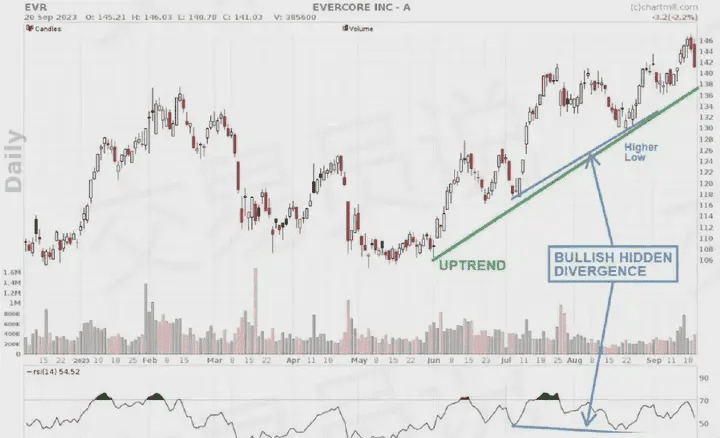
Example 2: Hidden divergence in a downtrend
Similar hidden divergences also appear in downward trends. Chemours stock peaked between July and August 2023, after which the price fell and formed several consecutive lows. However, the lower highs in the recent price formed higher lows in the indicator, which were identified as Bearish Hidden Divergences.
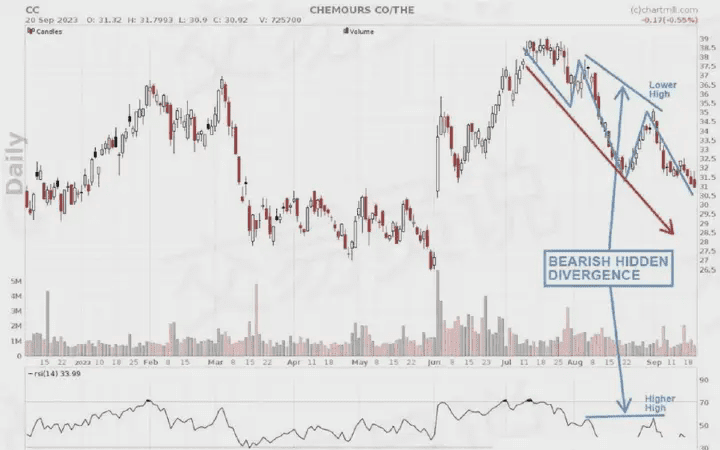
How to Use the RSI Indicator for Swing Trading
As we said at the beginning, the Relative Strength Index (RSI) is one of the many technical indicators that technical analysts use to profit from short-to-medium-term price fluctuations in the market.
After understanding the basics of RSI, next we will introduce in detail the different steps to successfully use the RSI indicator in swing trading strategies.
1. Choose the right timeframe
Typical swing trading strategies hold positions for days to weeks, so positions are also held overnight.
The default setting for swing trading is 14 periods on the daily chart, which corresponds to a 14-day time frame.
Shorter time periods generate more signals, but the margin of error also increases. Using longer periods, on the other hand, may miss some price movements.
2. Determine the current trend
The probability of success is greatest when trading along the main trend. For example, you can use the 200-day moving average to determine the long-term trend. For long positions, only select stocks whose long-term average line is trending upward and the price is above the average line.
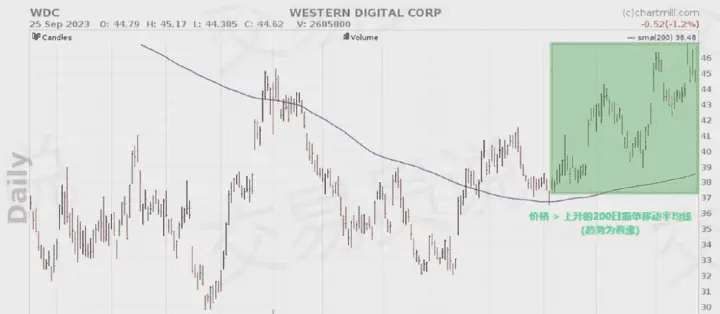
Another purely visual way to determine the current trend is to use an ascending trend line (requiring at least three connection points).
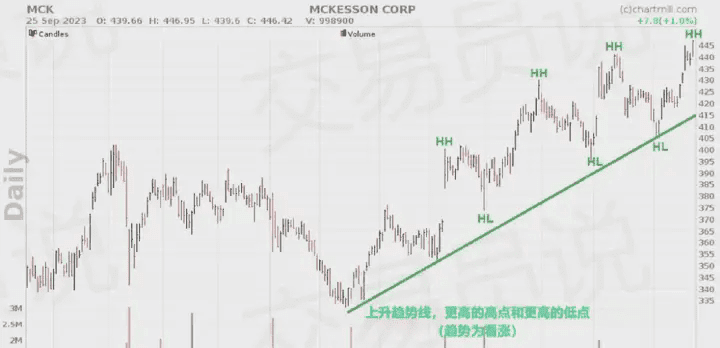
3. Determine (and optimize) RSI signals
We also introduced above that, typically, the RSI indicator's 70 and 30 values are used to identify overbought and oversold assets, respectively, which may foreshadow potential trend changes.
However, don't be too rigid about these levels; many factors depend on the momentum and strength of the existing trend. For example, in a strong upward market, a temporary reversal in prices does not always cause the RSI to fall below the 30 level.
Similarly, in a strong down market, a temporary rebound in prices does not necessarily mean that the RSI will rise above the 70 level.
In the above cases, a valid buy or sell signal may have been triggered when the RSI value bounced back from the 50 level.
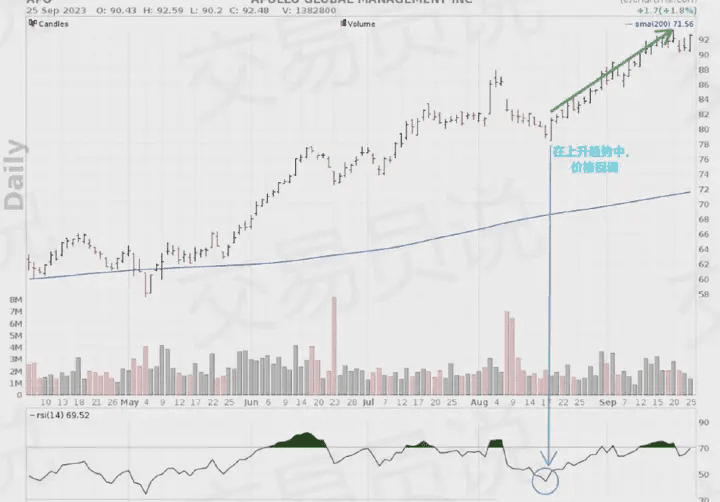
4. Don't rely solely on indicators.
Technical analysis and its indicators do not guarantee trading success. Trading purely based on this indicator or any other indicator is the fastest way to lose money!
As mentioned above, you should only trade in the direction of the long-term trend. After all, this will help you avoid many false signals.
In addition, always pay attention to price action. Chart patterns, candlestick patterns, and support and resistance levels that appear simultaneously with indicator signals are important confirmation signals that can significantly improve the reliability of trading setups. Remember, the number of signals does not matter, quality is key.
5. RSI Divergence
We have already understood the types of divergence and their meanings above. Hidden divergence is especially important when looking for entry points in strong trends.
Hidden divergence is a derivative of classical divergence and mainly appears in stocks with obvious upward or downward trends.
Hidden divergence appears when prices temporarily fall in an uptrend or temporarily rebound in a downtrend.
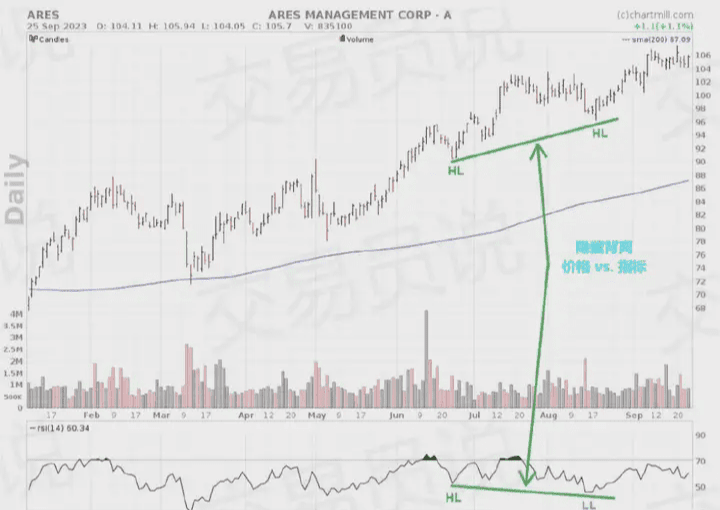
6. Precisely determine entry and stop-loss points.
Develop a trading plan and execute trades according to the plan!
According to your strategy, determine the entry and stop-loss points in advance. This ensures that you can accurately determine and limit risks. After all, protecting account funds is the top priority of every trader.
The exit point can be a pre-scheduled fixed price level, but another option is to use a trailing stop-loss to profit from the trend for as long as possible and protect a larger portion of the accumulated profit as the price moves further in a favorable direction.
7. Position size and risk management
Just as important as the trading setup itself is how you determine position size and its associated risk (related to the set stop-loss).
Only traders who can properly manage losing positions and ensure that losses remain small can remain successful in the long run. Five consecutive losses of 1% of the overall funds is not a disaster. However, a few open positions that individually cause the portfolio to lose dozens of percentage points are disastrous!
Frequently Asked Questions
1. What is the difference between RSI and Relative Strength?
"RSI" and "Relative Strength" are sometimes confused because they both contain the term "Relative Strength." However, they refer to completely different concepts:
● Relative Strength Index (RSI): is a technical indicator used to measure the strength and momentum of price movements of a financial instrument. It is an oscillator ranging from 0 to 100. The RSI helps traders identify overbought and oversold market conditions, potential trend reversals, and divergences between price and momentum by comparing the magnitude of recent gains to recent losses over a given period (usually 14 days).
● Relative Strength (in the investment field): is a tool to measure the performance of one investment or asset class relative to another. It is used for portfolio management and asset allocation, so it is not an indicator like RSI. Relative strength can be calculated by dividing the performance of one asset class (or investment) by the performance of another, used to determine which assets are performing stronger (outperforming) or weaker (underperforming) relative to a benchmark or another asset.
2. What is the difference between RSI and Stochastic-RSI?
Stochastic-RSI, like the ordinary Stochastic, is a momentum indicator primarily used to identify overbought or oversold levels. Adding the word 'RSI' means that Stochastic-RSI is a derivative of the ordinary RSI indicator. The difference from the ordinary Stochastic indicator is that Stochastic-RSI relies on RSI values, rather than the price of the underlying asset.
However, the formula used to calculate the values remains the same.
3. Is RSI a good indicator?
The Relative Strength Index is a valuable tool in technical analysis, but traders and investors should be aware of its limitations.
For example, it is often used to identify overbought (above 70) and oversold (below 30) conditions. However, these levels do not provide certainty. In fact, the market may persist in extreme conditions for a long time, and relying solely on RSI as entry and exit points may lead to (and often will) false signals.
The same applies to so-called divergence signals (when the RSI and price move in opposite directions). This is a signal pointing to a potential reversal, but it is not always reliable. This divergence may also last for quite a long time, leading to missed trading opportunities or premature entry.
In addition, its effectiveness varies depending on the selected cycle (usually 14 days). Shortening the cycle makes the indicator more sensitive but may generate more false signals; lengthening the cycle reduces sensitivity but may cause signal delays.
This does not mean that RSI signals are not valuable when combined with other technical or fundamental information.
4. Can the RSI be used for day trading?
Yes, it is very popular among day traders. It is a versatile technical indicator that can be applied to various time frames, including intraday charts, making it suitable for intraday trading strategies.
Day traders can adjust the period according to their trading style and trading assets. Shorter periods (e.g., 9 or 5) are more sensitive and suitable for ultra-short-term trading; while longer periods (e.g., 14 or 21) are more suitable for slightly longer intraday trading.
Mu Qing only does real trading, the team still has positions, come on board quickly $BTC $ETH

